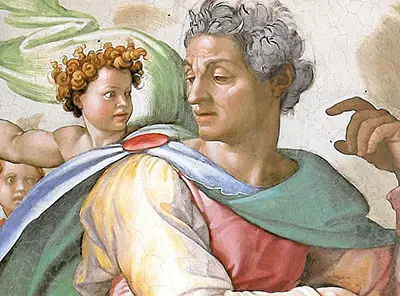In the painting, Isaiah holds a half closed book as he turns to look at his attendant Putti who seems to have distracted him. His bare feet are crossed, his face is attentive and his hair is gray.
Isaiah's neck emerges from his red and blue-greenish robe that symbolises faith, hope and charity. The half closed book symbolises that listening to the voice is more important than reading the book.
The ceiling of Sistine Chapel Fresco
In 1506, Pope Julius commissioned Michelangelo to paint the ceiling of Sistine Chapel. The diligent artist began working on the project in 1508 and completed it after five years. Along with Prophet Isaiah, there are six other prophets and five sibyls painted on the chapel ceiling.
All the depicted prophets hold a book, perhaps symbolising prophecy. In addition to Isaiah, Michelangelo also illustrated:
- Joel: In this Image, one genii above the prophet closes Joel’s book while looking over his shoulder while the other brings him a piece of paper. The prophet distinctly shifts his body to the left.
- Zechariah (1509): Zechariah’s painting is that of a bearded old man dressed in a green cloak and two genii looking over his shoulder. One can see this prophet upon entering the chapel through the door located in the east.
- Ezekiel (1510): Ezekiel faces Zechariah to the left. His head is covered in a white turban and he moves his body, particularly his hand to the right. According to critics, this is indicative of surprise, surrender and imparting of vision.
- Daniel (1511): A genii under his mantel helps him hold up the book of life while Daniel is immersed in reading and writing.
- Jeremiah (1511): Deep in thought, he holds his chin and he looks to the floor. One little attendant looks on woefully, the other one is feminine.
- Jonah (1511): Jonah looks directly to the sky and his muscular legs are exposed. The composition of this drawing is slightly different from the others to indicate the rebellious nature of Jonah. His genii form an animated background.
Five Sibyls
These were women who prophesied at shrine and temples in the classical world. The five Sibyls depicted in the Sistine Fresco are believed to have foreseen the birth of Jesus. Prophets David and Isaiah are between the holy women.
Three of them (Delphican, Cumaean and Lybian) on one side and the other two (Erythraean and Persian) on the other side, Prophet Ezekiel is between these two.
Style and Detail
The fresco is created with harmonised bright colours. He painted them freely and incorporated a lot of dynamism. It is quite obvious that Michelangelo admired and understood the human figure. His frescos were of humans wearing simple robes and with some of body parts exposed. Unlike artists like Leonardo da Vince, Michelangelo used curves and diagonals in his sketches. His figures were twisted around and complimented each other.
The Last Judgment
This is a shocking masterpiece that was indicative of the changes Rome underwent in 1527 following the Sack of Rome. The piece shows well preserved and skeletal zombies crawling out of the graves in an image that is reminiscent of great last judgment series which Signorelli painted in the Cathedral at Orvieto. The content was surprising to many because the piece was created after the Sistine Chapel Fresco which was very beautiful.
Conclusion
Michelangelo was a versatile renaissance artist who created memorable pieces. From the Sistine ceiling Chapel painting to the Statue of David, all are timeless and pieces known by every art lover. Many years after their creation, visitors flock Florence to see his works of art.


